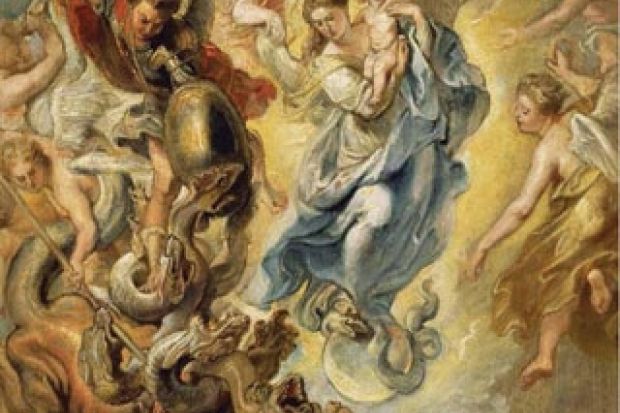Is the “Catholic Rubens” the forgotten and misunderstood Rubens? Eminent German art historian Willibald Sauerländer certainly thinks so. In this sumptuous book he argues that art history excised Rubens as a religious artist from the historiography in favour of a more fashionable idea of his being the master of “Baroque passion”; a concept, says Sauerländer, that has been “vulgarized” by contemporary media. His case that Rubens’ faith is an unpopular topic may be illustrated by the fact that this volume was published not by a commercial publisher but by the Getty Research Institute, whose director, as the acknowledgements note, is a friend.
The origins of this lopsided view lie, for Sauerländer, in the writings of intellectuals of an “enlightened mind”, such as Friedrich von Schlegel, Hippolyte Taine and even the Swiss cultural historian Jacob Burckhardt, who all evaded detailed engagement with the Catholicism in Rubens’ art. His altarpieces received attention as “aesthetic trophies” decoupled from their liturgical context of ritual, space and associated devotional objects. Perusing the separate chapters on Rubens’ altarpieces of saints and martyrs in this beautifully illustrated book underscores the extent to which waves of secularist movements in the vanguard of the French Revolution destroyed the topography of Catholic life as Rubens knew it. Few of Rubens’ altarpieces are still in situ, with the painting of St Roch in the church of St Martin in Aalst a rare exception. For Sauerländer, however, it is not only the patchy and incomplete material legacy, but the “cognitive and ethical chasm” that disconnects the modern viewer from Rubens’ Catholicism; a rupture that not even erudition and scholarship can truly bridge. For anyone teaching Rubens to students who think the Trinity is Mary, Joseph and the baby Jesus, Sauerländer has a point.
A specialist on French medieval sculpture and an agnostic of Protestant extraction, Sauerländer humbly admits he may not be the obvious scholar to make this intervention. He confesses that the belligerent character of Rubens’ The Virgin as the Woman of the Apocalypse for Freising Cathedral makes him “wince”. Yet his aim is to reinstate the complexity of Rubens’ religious works by showing that they mesh spirituality and sensuality, flesh and religion, horror and grace, pain and salvation. Such work cannot be reduced to either “gruesome” or “gory”, but has a distinct celebratory quality in its promise of divine mercy. The “sensuous charisma” of Rubens’ altarpieces is to be found in religion and not severed from it.
The book impresses not through novel interpretations and source material, but through its scope, comprehensiveness and careful study of primary textual sources, all published here in their original language with English translations. Although we do not learn much about the wider debates of post-Tridentine image policies, Sauerländer gives an excellent sense of the considerable geographical dissemination of Rubens’ inventions and the institutional and denominational diversity of his ecclesiastical clients and their role in the final composition. However, as a chapter on the rejected proposal for the St Bavo altar in Ghent Cathedral illustrates, the visual language that Rubens formulated to sensualise and energise old principles of faith that had come under attack did not always meet with unanimous applause.
This is a book that should not be missed by anyone interested in Rubens and the visual culture of early modern Europe.
The Catholic Rubens: Saints and Martyrs
By Willibald Sauerländer, translated by David Dollenmayer
Getty Research Institute, 312pp, £34.95
ISBN 9781606062685
Published March 2014
Register to continue
Why register?
- Registration is free and only takes a moment
- Once registered, you can read 3 articles a month
- Sign up for our newsletter
Subscribe
Or subscribe for unlimited access to:
- Unlimited access to news, views, insights & reviews
- Digital editions
- Digital access to THE’s university and college rankings analysis
Already registered or a current subscriber? Login





